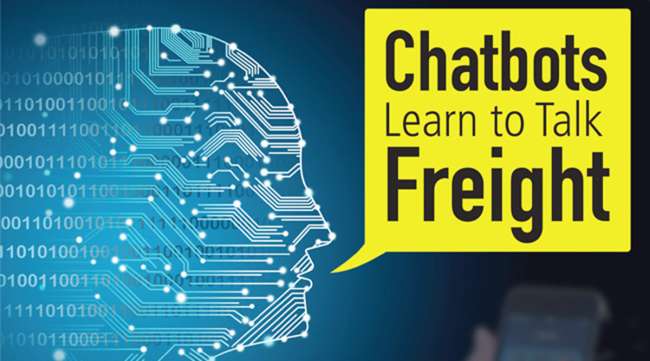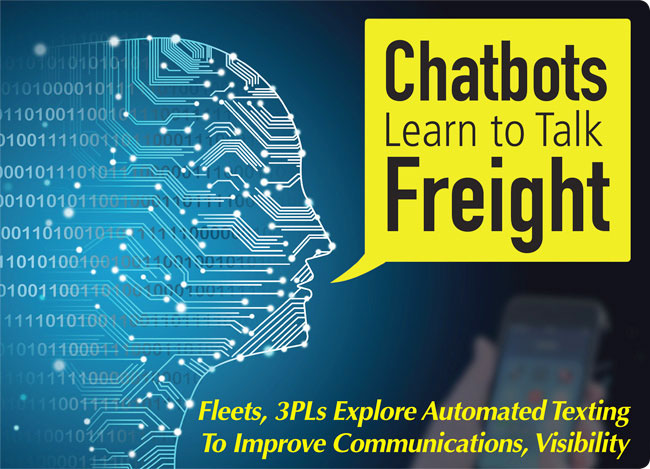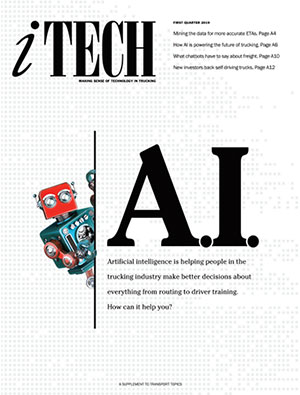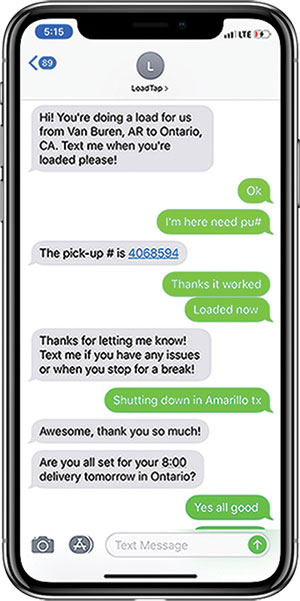Chatbots Are Emerging as Powerful Tools for the Transportation Industry


The driver arrives at the warehouse, but the shipment is not ready. He sends a message asking about the timeline of the delay and, immediately, the driver receives a response about when the late load will be ready.
Behind the scenes, the logistics managers waiting on that shipment are notified that the driver will be late, and an updated loading and delivery schedule is sent to the driver. The driver also is rerouted from his original schedule to avoid traffic congestion at a certain time along the freeway.
The driver may be surprised that his entire schedule for the day has been changed within seconds, but other than that, he finds the interaction pleasant and even receives a “Thank you and have a great day, Ted” before signing off.
But unaware to the driver, he has been interacting not with an ultra-efficient human, but with a chatbot.
As this use-case scenario shows, artificial intelligence-powered chatbots are often not even known as such by the user. Instead, they are often packaged among the automated features of enterprise resource planning systems increasingly used by shipping firms as AI and data science continue to evolve.

Read more iTech stories:
“For our user, they don’t even know there’s a chatbot in the background that is collecting a lot of this information. And the chatbot is just a way to collect information and relay it back and forth between the driver and dispatcher,” said Paramvir Sandhu, CEO and co-founder of LoadTap, a provider of automated load-tracking technology for logistics firms and freight brokers. “It’s happening in the background and our customer magically just sees updates and notifications come out on the front end — so, the user may not even know it’s happened.”
While the use of chatbots has been increasingly identified as an improved medium to engage drivers, the idea is not to sell chatbots per se, but to embed the technology within automated logistics operations, Sandhu said.
“Chatbots represent an individual feature among many in an automated system,” Sandhu said. “The idea is to empower customers to save time, gain visibility into shipments and gain visibility into issues that are happening.”
Advances in Technology
Chatbots are emerging as powerful tools for the transportation industry thanks to improved computing power and access to data in real time, said Torsten Volk, a managing research director at Enterprise Management Associates, a technology research and consulting firm.
“Much more training data is available coupled with much improved hardware for artificial intelligence to learn from that data,” Volk said. “You program chatbots by chaining together learning models and binary rules to ultimately end up at a specific actionable result.”
When a driver interacts with a chatbot by text or even voice in ways similar to how Amazon’s Alexa or Hello Google operate, the system does not “understand what you are talking about, but has massive inference models at its disposal that lets them ‘understand’ all the different ways there [are] to relay information and answer questions [relating to shipping],” Volk said.

Among the technologies on offer, LoadTap chatbots are offered as one component as part of a comprehensive automated tracking solution — which is commonly integrated into an ERP system.
Some large carriers are also exploring chatbots as a way to improve efficiency.
Schneider is developing chatbots as part of “several initiatives underway with regard to intelligent robotic automation of our business processes,” said Shaleen Devgun, chief information officer and executive vice president at the Green Bay, Wis.-based truckload fleet.
“We are developing and implementing various forms of automation to support drivers utilizing our cutting-edge telematics platform as the avenue to improve their work experience,” Devgun said. “This platform provides the ability to utilize chat and chatbots as a channel to meet these needs.”
Schneider ranks No. 7 on the Transport Topics Top 100 list of the largest for-hire carriers in North America.
Parcel-delivery giant UPS Inc. has been offering its customers the use of chatbots since 2016 to track packages, find locations, get shipping rates and other information. Customers can interact with chatbots by text commands via Facebook Messenger, Skype and Amazon or by voice through Amazon’s Alexa.
UPS, which ranks No. 1 on TT’s Top 100 list of for-hire carriers, is also the first U.S. package delivery company to offer a chatbot experience specifically designed for delivery-recipient customers, a UPS spokesman said in an e-mail response.
Chatbots represent an “excellent example” of how “AI enables valuable solutions for our customers,” the spokesman said. “UPS has been innovating for more than a century now. We know that artificial intelligence has potential in our business.”
The spokesman also said: “We see chatbots becoming an increasingly important communication tool over the next few years.”
Chatbot Adoption
Third-party logistics companies have expressed the most interest in chatbots, at least initially, within LoadTap’s customer base, Sandhu said.
For Jason Yeager, chief operating officer at Dynamic Logistix, chatbots are a useful tool with many available features to boost delivery efficiencies.
“The logistics space is comprised of so many spirited personalities and unique backgrounds that we must use a variety of dynamic communication methods to successfully connect with our carriers,” Yeager said. “Drivers are accustomed to providing updates via their phone and text message. AI-enabled chatbots allow drivers to provide critical updates in a timely manner that is convenient for them but automated for our team.”
Typical technology platforms for tracking and communications in the trucking industry include in-cab telematics systems, mobile phone applications and electronic logging devices.
Jason Doris, a certified broker at AM Transport Services, said the introduction of automated texting contributed to higher adoption of mobile communications and tracking technology in the commercial truck sector.
“We saw adoption of the cellphone tracking increase but not as rapidly as the response rate on the automated texting. Our operations team found that drivers preferred texting for everything,” Doris said. “This was all before the ELD mandate came into effect, and since then, we have seen an increase in carriers allowing access to those devices for tracking purposes.”
Some carriers are warming to the idea of utilizing chatbots in freight operations.
While the adoption of new technologies in the transportation industry may be accelerating, “our industry has traditionally been slow adopters of technology,” said Robert Loya, director of operations at drayage company CMI Transportation. “But chatbots are certainly something that can be very useful at some point, as the industry evolves.” ³




